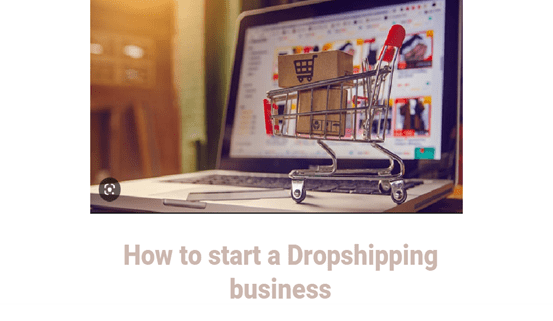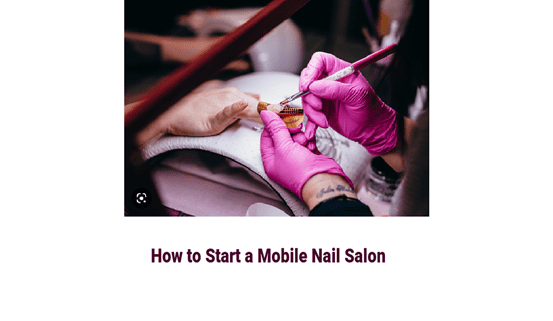How To Start a Dropshipping Business 17+ Easy Steps

Hey there,
If you were wondering,
How to start a Dropshipping Business?
You are in the right place.
Starting a dropshipping business is a great way to get into e-commerce without having to handle inventory or shipping. In this post, we’ll walk you through the basics of setting up a dropshipping business, including choosing a niche, finding a supplier, and building your online store. Whether you’re a complete beginner or just looking to expand your existing business, this guide will help you get started.
What Is a Dropshipping Business?
What Is a Dropshipping Business? A dropshipping business is an e-commerce business where you don’t have to handle any physical products. Instead, you work with a supplier who ships products directly to your customers.
Essentially, you act as a middleman between the supplier and the customer. You create an online store, and when you receive an order, you forward it to the supplier. The supplier then ships the product to the customer, and you keep a percentage of the sale.
The great thing about dropshipping is that you don’t have to worry about inventory or shipping, which makes it a low-risk way to start an e-commerce business. Plus, you can run your business from anywhere with an internet connection.
The downside is that you often have less control over the quality of the products and shipping times, so choosing a reliable supplier is essential. Dropshipping is a great way to get your feet wet in e-commerce and start making money online.
Dropshipping Business Made Easy: a Step-by-Step Guide
Want to start dropshipping biz but feeling lost? Don’t worry; we got you covered. Check out our step-by-step guide to make the process easy peasy.
1 – Researching Potential Niches
When deciding a market to focus on for your products, it’s essential to look into a niche that you are passionate about and has proven monetary success.
While researching these specialties, consider the size of this sector, the level of rivalry present in the said industry, and how profitable its products will be.
To help with this process, try taking advantage of helpful tools such as Google Trends or Amazon Best Sellers in addition to social media platforms like Instagram and Pinterest.
Researching trending products on dropshipping platforms such as Aliexpress, Oberlo, and Spocket can provide valuable insight into what items are currently in high demand.
Keyword research tools will allow you to discover what goods people desire and the words they use to search for them online.
As markets evolve, it’s imperative that your niche does, too; remember that finding a profitable one is an ongoing process rather than a single event.
2 – Choosing a Profitable Niche
Before deciding on a niche, you must ensure its profitability. To determine the effectiveness of a potential market, conducting comprehensive research is key – evaluating parameters such as the size and demand for that space, how many other businesses are offering similar products or services, and what kind of returns these businesses see from their investments.
By performing this analysis, you can ensure your venture meets certain expectations before beginning any project.
Before you launch your business, evaluating its potential size and competition is essential. Utilizing Google Trends, Amazon Best Sellers, and social media platforms can give you a better understanding of the market.
Additionally, examining profitability is integral; be sure to assess profit margins, product prices, and shipping costs to determine how lucrative each sale may be for your business.
While tools such as Jungle Scout, Helium 10, and AMZScout can offer insight into the profitability of certain products, it’s essential to think about your target audience.
Analyze their needs and pain points to identify precisely how your product will fulfill them.
Remember, selecting a niche is not merely about finding large numbers of customers but also one with significant profit margins that inspires enthusiasm in you.
Aim for a narrower customer base if necessary; high-profit niches are far more desirable than wide ones with low returns on investment.
3 – Finding a Reliable Supplier or a Dropshipping Platform
Choosing the right supplier for your online store is critical to ensure success. It would be best if you were sure they are reliable, have a good reputation, offer high-quality products at a competitive price, and provide stellar customer service.
A dropshipping platform can help connect you with numerous suppliers; this way, you can easily import goods into your store without all of the hassles associated with traditional methods. When examining potential suppliers, it’s essential to consider product quality, shipping times, and customer service – these will make or break any business.
Guaranteeing that your supplier is reliable, with prompt shipping and excellent customer service, should be of utmost priority. To locate quality suppliers, you can take advantage of wholesale directories or dropshipping platforms such as Alibaba, Oberlo, and Spocket.
With these platforms, you can quickly find the perfect suppliers for your needs by browsing through their vast selection of products. You can also explore external sources such as Google or other search engines to discover new manufacturers.
Of course, it’s not only about finding a supplier with the goods you need – but one with an excellent reputation and good communication too! Ensure they have reliable shipping services and customer service so that everything goes smoothly when clients purchase from them.
To ensure that you’re getting the best quality, packaging, and timely delivery from your supplier, you must order a sample product for testing.
Additionally, guaranteeing mutual understanding between both parties on payment terms and return policies is invaluable in establishing a successful business relationship with them.
4 – Deciding on a Business Model and Pricing Strategy
You must set up the correct business model and pricing strategy to succeed when developing a dropshipping business. A great option is a retail arbitrage – buying products from a supplier at one price point and selling them in your store for more money.
On the other hand, private labeling allows entrepreneurs to create their unique brand identity while having manufacturers produce goods under that name. Both of these models can result in healthy profits if executed correctly.
When setting the cost of your product, you’ll need to review all costs, such as production expenses, shipping, and handling, before applying a markup for desired profits.
To determine a fair value, you can also explore what other companies are charging for comparable products. And don’t forget that if your item is distinctively premium or solves an issue with no alternative solution, you may be able to charge more due to its greater worth.
Offering promotions and discounts will not only spur sales but also helps to create customer loyalty. Nevertheless, consider that formulating the best pricing strategy is an ongoing endeavor. As you become more familiar with your customers’ preferences, costs, and market conditions — review and revise prices accordingly for optimal returns!
5 – Set up a Legal Business Entity
Establishing a solid business structure is vital to shield your personal belongings while making it more straightforward for you to do business. The most common types of company forms are sole proprietorship, partnership, limited liability company (LLC), and corporation; each type differs in its laws within the jurisdiction and tailored goals that fit your or your organization’s needs.
If you are the only proprietor and manager of your business, a Sole Proprietorship is probably the most effortless and appropriate entity to set up. Despite its convenience, it won’t give you any protection from liability or other legal issues; hence be sure to seek advice from an accountant or attorney before deciding which option suits your needs best.
In addition to shielding your assets, creating a legitimate business entity is essential while pursuing a bank account for your business, acquiring permits and licenses necessary for operations, and obtaining a credible business credit card.
6 – Set up an Online Store
Offering your goods to customers through an online store requires some forward-thinking and preparation. To build a digital shop front, you have three primary options: creating a website from the ground up, utilizing e-commerce platforms like Shopify or BigCommerce, or taking advantage of automated website builders. You can launch your virtual storefront without needing technical know-how with any of these approaches.
If you’re in the market for a website, why not leverage an e-commerce platform? You’ll enjoy access to countless features, such as payment gateway integration, inventory management, and shipping & tax calculators.
Plus, these platforms come with various templates and apps to help you personalize your store according to your brand identity.
Of course, there is always the option of building a site from zero; however, this could prove more time-consuming and costly than using an existing eCommerce platform – but it gives you complete control over design & functionality.
Building your online store is a breeze when utilizing website builders like Wix and Squarespace.
With their extensive selection of templates, drag-and-drop design tools, and simple setup process, it’s effortless to create an eye-catching storefront that perfectly reflects the essence of your brand.
You can ensure customers have no trouble navigating through your store by providing an intuitive user experience crafted for maximum convenience. Creating a professional-looking eCommerce site has never been more accessible. It’s also essential to ensure that your store is mobile-friendly as more and more people are shopping on their mobile devices.
You should also test the checkout process, shipping, and taxes calculation to ensure they work correctly and provide a smooth customer experience.
8 – Creating a Branding Strategy
A branding strategy is a must-have for any business. Not only does it help you build trust with your customers, but it also differentiates you from the competition and creates a unique identity for your products. Crafting an effective plan to present yourself to the world will undoubtedly lead to success in both short and long-term goals.
Crafting a compelling brand identity is critical for any business. Think about your company’s mission and values, the people you are targeting, and why customers should choose your product or service.
Assemble a memorable name, logo, and tagline that will stick in peoples’ minds when they think of you. Establishing a visual style that can be used on all marketing assets such as website graphics, social media content images & video variations, and product packaging designs helps to keep consistency across platforms – this way, people know it’s YOU.
Constructing a compelling brand identity ensures your business stands out from the competition. Utilize various features such as colors, typography, and imagery for this purpose.
Additionally, establish a refreshing voice that resonates with your company’s core values across your digital channels – website, social media profiles & customer interactions alike! Your branding strategy should not be limited to crafting only a logo or tagline; it must effectively craft a distinct persona to construct trust between you and potential customers.
To ensure your brand is visible and accessible to the right people, you must factor in SEO when creating a branding strategy. This includes structuring your website’s URLs, meta-tags, and other elements so that it can be located through search engines quickly and reliably.
9 – Building a Website or Using an E-commerce Platform
A website is essential to your business as it will be the primary way customers find and interact with your products.
When building a website, you’ll need to choose a domain name, which is the address of your website, and a hosting provider, which is the service that will store and deliver your website to customers. You can use website builders like Wix, Squarespace, or WordPress to create a website without needing technical expertise.
If you decide to use an e-commerce platform, you’ll be able to create an online store without needing to build a website from scratch. Popular e-commerce platforms include Shopify, BigCommerce, and WooCommerce.
These platforms offer many features, including payment gateway integration, inventory management, and shipping and tax calculators. They also provide a variety of templates and apps that can help you customize your store to fit your brand.
When building a website, it’s important to remember that it should be easy to navigate, provide a good user experience, and be mobile-friendly as more people shop on their mobile devices. You should also ensure that your website is secure and that you have an SSL (Secure Sockets Layer) certificate to protect your customers’ personal information.
You should also ensure that your website is optimized for SEO (Search Engine Optimization) so that it will be easy for customers to find your products through search engines like Google.
10 – Creating Product Listings and Descriptions
Crafting the perfect product listings for your e-commerce store is essential to ensure customers can find and understand your offering. Include everything from high-quality visuals to titles, descriptions, pricing details, and available options (e.g., size or color).
Furthermore, ensure that each photograph captures the item from various angles so all aspects of it can be seen clearly; this way, potential buyers won’t need any more information as they will have a complete idea of what it looks like. With well-thought-out product listings & images, you’ll set yourself apart from competitors who fail at providing sufficient detail about their products.
When crafting product descriptions, ensure that they are exhaustive and explanatory. Include essential attributes such as features, advantages, and technical specifications. Additionally, make sure your writing is enjoyable yet straightforward to read; moreover, include applicable keywords to facilitate better search engine placement of your products.
Don’t forget to consider the customer’s point of view, too – be sure to address potential queries while emphasizing the product’s unique selling points.
It’s essential to ensure that your product descriptions reflect your branding strategy and embody the spirit of your brand.
After all, it’s not just about providing info – these listings must be persuasive enough to encourage customers to buy! Crafting a compelling message will help you create an unforgettable shopping experience for potential buyers.
11 – Setting up Payment and Shipping Options
Providing your customers with an array of payment and shipping options is fundamental for a successful business. Incorporate secure, user-friendly methods such as credit cards, PayPal, or other online payments to make the process convenient for them.
Additionally, you must ensure that your payment gateway meets industry standards like PCI DSS (Payment Card Industry Data Security Standard) so customers can trust their information remains safe throughout the transaction.
You’ll want to include standard, expedited, and international shipping when setting up shipping options. You should also make sure you can calculate shipping costs based on the customer’s location and the weight of the products they are ordering.
It’s essential to remember that shipping costs can significantly impact a customer’s decision to buy, so you should ensure that you offer competitive shipping rates.
It would be best if you also considered offering a free shipping option for orders over a certain amount or for a limited time. This can help to increase sales and encourage customers to buy more products.
It’s also important to keep in mind that shipping options and costs will vary depending on
12 – Developing a Marketing Plan
A marketing plan is a strategy for promoting your products and growing your business. Without a marketing plan, attracting customers and generating sales will be challenging.
When developing a marketing plan, you’ll want to consider your target audience, your budget, and the channels you will use to reach your customers. You should also ensure that your marketing plan is aligned with your branding strategy and reflects your brand’s personality and values.
There are many different channels that you can use to promote your products, including social media, email marketing, content marketing, and paid advertising. Each channel has its strengths and weaknesses, so you’ll want to choose the channels that will work best for your business.
Social media platforms like Facebook, Instagram, and Twitter can be powerful tools for reaching potential customers and building a community around your brand. Email marketing can be a cost-effective way to stay in touch with customers and promote new products.
Content marketing can help you build trust with your customers and position yourself as an authority in your niche. Paid advertising can be a fast way to reach a large audience and generate sales.
Remembering that a marketing plan is not a one-time thing; it’s an ongoing effort. You’ll need to constantly evaluate the effectiveness of your marketing efforts and make adjustments as needed.
13 – Test the Website
Testing the website is evaluating your website’s functionality, usability, and performance to ensure that it’s working correctly and providing a good user experience.
When testing the website, you’ll want to check things like the checkout process, the payment gateway, the shipping and tax calculators, and mobile responsiveness. You should also ensure that your website is secure and that you have an SSL (Secure Sockets Layer) certificate to protect your customers’ personal information.
You should also test the website’s load time and ensure that it loads quickly, especially on mobile devices, as customers are likely to leave a website that takes too long to load. You can use website speed tests tools like Google PageSpeed Insights or GTmetrix to test the load time of your website.
You should also test the website’s compatibility with different browsers and devices, as some website elements may not work correctly on specific browsers or devices.
It’s also essential to test the website’s SEO (Search Engine Optimization), and make sure that it’s optimized for search engines like Google so that it will be easy for customers to find your products.
It’s essential to test the website with various scenarios and users to ensure that it provides a good user experience and that it’s easy for customers to find and purchase products. This will help you to identify and fix any issues before your website goes live.
14 – Launching and Marketing
Launching your website is making it live and available to customers. Marketing your website is promoting it to potential customers and generating sales.
When launching your website, you’ll want to ensure everything is in place and working correctly.
This includes the checkout process, the payment gateway, the shipping and tax calculators, and the website’s mobile responsiveness.
You should also ensure that your website is secure and that you have an SSL (Secure Sockets Layer) certificate to protect your customers’ personal information.
Marketing your website is an ongoing effort that begins before the launch and continues after the launch. Your marketing efforts should be aligned with your branding strategy and target audience.
It would be best to use a combination of channels like social media, email marketing, content marketing, and paid advertising to promote your website and generate sales.
It’s also essential to use various analytics tools to track the performance of your website and marketing campaigns. This will help you understand which channels work best for you and which areas need improvement.
You can also use A/B testing to test different elements of your website and marketing campaigns to see what works best.
It would help if you also used retargeting and remarketing techniques to reach the visitors who left your website without making a purchase.
Launching and marketing your website is vital to getting your dropshipping business and reaching your target customers.
15 – Monitoring Store Analytics’
Monitoring store analytics tracks and analyzes data about your website’s performance, customers, and sales. This information can be used to make informed decisions about your business and improve its performance.
There are several key metrics that you should track when monitoring store analytics, including website traffic, conversion rates, customer demographics, and sales data.
Website traffic data can be used to understand how many people visit your website, where they’re coming from, and what pages they see. This information can be used to identify which marketing channels are driving the most traffic and which pages are the most popular.
Conversion rate data can be used to understand how many visitors to your website are becoming customers. This information can be used to identify which pages are most effective at converting visitors into customers and which pages are causing visitors to leave.
Customer demographics data can be used to understand who your customers are, their location, and what products they’re interested in. This information can be used to create targeted marketing campaigns and improve the customer experience.
Sales data can be used to understand how many products you’re selling, how much revenue you’re generating, and which products are the most popular. This information can be used to identify which products are most profitable and which products need to be promoted more.
Overall, monitoring store analytics is essential in understanding your business’s performance and making data-driven decisions to improve it.
16 – Optimizing for Conversions
Optimizing for conversions is the process of making changes to your website and marketing efforts to increase the number of visitors who become customers.
There are several key areas that you can focus on when optimizing for conversions, including website design, copywriting, and user experience.
Website design plays a crucial role in conversions, and it’s vital to ensure that your website is visually appealing, easy to navigate, and provides a good user experience. You should also ensure that your website is mobile-friendly, as more and more people are shopping on their mobile devices.
It’s crucial to ensure that your product descriptions and calls to action are compelling and persuasive. Ensuring that your website is easy to use and provides a smooth checkout process is essential to conversions.
You can use A/B testing to test different elements of your website and marketing campaigns to see what works best.
It would be best if you also used heatmap and session recording tools to understand how visitors interact with your website and identify any issues causing them to leave.
Overall, optimizing for conversions is an ongoing effort that requires constant testing, experimentation, and analysis to identify and improve the factors that are affecting conversions.
17 – Improving Product Offerings
Improving product offerings is the process of identifying and adding new products, or making changes to existing products, to improve the overall value your business provides to customers.
There are several key areas that you can focus on when improving product offerings, including product research, product development, and product sourcing.
Product research is the process of identifying new products or product trends that customers demand. This can be done by analyzing data from your store analytics, customer feedback and by monitoring trends in your niche.
Product development is creating new products or changing existing products to improve their value. This can include adding new features, improving product quality, or creating new product bundles.
Product sourcing is the process of finding new suppliers or making changes to existing suppliers to improve the quality and price of your products. This can include finding new suppliers who can provide better quality products at lower prices or finding new suppliers who can deliver products your competitors do not currently offer.
Overall, improving product offerings is crucial in staying competitive, increasing sales, and providing more value to your customers. It’s an ongoing effort that requires constant research, experimentation, and analysis to identify new opportunities and adapt to market trends.
18 – Staying Up-to-date with Trends
Staying up-to-date with trends is keeping track of current market trends, industry changes, and new technologies that may impact your business. You can adjust your business strategy and operations to stay competitive and grow by staying informed of these trends.
One significant trend to stay up-to-date with is e-commerce and online shopping trends. With more and more customers shopping online, it’s essential to understand how to optimize your website for conversions, improve the customer experience, and stay ahead of the competition.
Another critical trend to stay up-to-date with is social media and digital marketing trends. As social media and digital marketing channels evolve, it’s essential to understand how to effectively use them to reach your target audience, promote your products, and build your brand.
You should also stay up-to-date with the latest technologies and tools that can help you to automate and streamline your business operations. This can include things like inventory management software, customer relationship management software, and analytics tools.
Lastly, it’s essential to stay informed of legal and regulatory changes that may affect your business, such as changes to online sales tax laws, data privacy regulations, and consumer protection laws.
Overall, staying up-to-date with trends is essential to running a successful dropshipping business. It allows you to adapt to changes in the market, stay competitive and continue to grow your business.
Conclusion – How to Start a Dropshipping Business
Starting a dropshipping business can be a great way to start an online business with minimal investment and risk.
However, it’s essential to understand that starting a dropshipping business is not a “get rich quick” scheme; it requires hard work, dedication, and a solid business plan.
In this blog post, we’ve outlined steps that can help you to start a successful dropshipping business. These steps include researching your niche, finding a supplier, creating a brand, building a website, developing a marketing plan, and much more.
By following these steps, you’ll be able to create a strong foundation for your business and set yourself up for success.
However, it’s important to remember that starting a dropshipping business is an ongoing process that requires constant effort to stay competitive and grow. It would be best if you were willing to adapt to changes in the market, stay up-to-date with trends, and adjust your business strategy and operations as required.
SickofTheBoss.com is the brainchild of Jack Bastide. It is designed for entrepreneurs and those that want to be. You can find Jack on Facebook or Linked-In.






